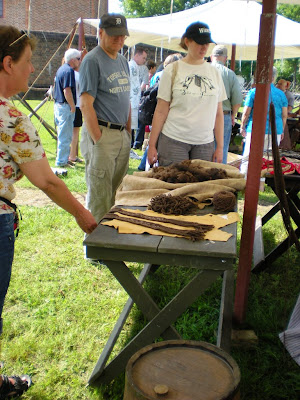In research produced by the Public History and American Indian Initiative departments, we have been lucky to discover that many Cherokee delegations visited CW. Some sources say that the Cherokee camped next to the magazine, borrowing tents from the magazine. They had trade goods, met with Virginia leaders and at night they ate, drank and danced.
This past weekend members of the Eastern Band of the Cherokee Nation "set up camp" outside the magazine. We were lucky to have the Warriors Anikituhwa there (though not performing, just hanging out, sharing their history, practices, and crafts) as well as the best basket maker in the Eastern Cherokee Tribe as well as the best buffalo weaver. It was quite cool, and I wish I could have gotten better pictures, but, there were so many visitors all day long that it was tough to get good shots unless I decided to push visitors out of the way :)
Larry Pourier has been here all week as well, and is staying for the duration of the week. He's Oglala Lakota from Pine Ridge, and is working in public history advising us on programming and he will be charge of seeking Native talent for our Fall public history programs. He hung out all day, dressed in period as an assimilated Indian in the militia.
This morning, I met with Larry, Buck and John Standingdeer Jr., the cultural ambassador for the Eastern Band and a surveyor for the tribe. We met various CW people at the Dewitt Wallace Museum to present Standingdeer with a replica of a peace medal that was is believed to have been given to a variety of Indian community members during the 18th century. This is a rare medal, and it's so cool that the collections department worked with our metalworkers to create a small number of replicas. So, first, here is one of my not so great photos of the presentation, and then some photos from the camp.
The camp was quite cool, I was just sad that I wasn't able to really meet anyone from the Cherokee. However, I'm glad I got to meet John today, he's a really cool guy, full of insight, passion, and knowledge and I look forward to working with him in the future. Same with Larry.
There was a lot of interesting stuff at the camp. Visitors were fairly well behaved, despite the classic comments of "my great grandma was Cherokee," which was mentioned quite frequently. I'd like to learn more about how Eastern Cherokee, and Oklahomans handle that. Buck and I also got the worst of the visitors, an older man in his late 60s to mid 70s asking me if I was "an Indian" (which I said "maybe...I could be...but no") and proceeded to tell Buck and I that alcoholism is the biggest problem on reservations and that Indians are making a ton of money from casinos and that they are all rich. As he proceeded to tell us this, and Buck diligently handled the man as I almost exploded, one of the Eastern Cherokee basket weavers just glanced at us, chuckled, and continued working on her amazing basket. Quite an experience.
It's just an honor to finally work closely with these Native peoples, learn more about how they see life, and where I can fit in as a historical thinker, as a politically concerned and active person, and socially. I know that sounds so immature, but, to finally but faces with the names, and link my recent life's work to these individuals that I have read about, studied, watched films of, handled objects once owned by...it's really awesome.
A member of the collections team, a "random 18th century guy" (as we called him), John Standingdeer, Jr. and Buck Woodard. John receives the medal.

Craftspeople from the Eastern Band of the Cherokee working on river cane baskets, pipe carving and buffalo hair weaving.
Visitors take the opportunity to fell the soft texture of the buffalo fur and speak with the craftspeople.

Basket maker from the Eastern Band of the Cherokee

Detail of river cane, a plant found on the bottom lands of mountains near streams and rivers.

River cane soaking.

Craftsman making pipe bowls.


Willie from the public history department moonlights as an Indian trader sharing traditional European trade goods with visitors.

Detail of trade goods

The Warriors share their talents, history and culture with visitors. Here people were able to learn about the art of moccasin making.

John Standingdeer Jr. (Eastern Band of Cherokee), Larry Pourier (Oglala Lakota) and Buck Woodard (Lower Muskogee Creek) man the camp.

Visitors and members of the Eastern Band of the Cherokee.
and now for something completely different
two awesome shots of the carpet at the governors mansion








Yes it is true that cherokee played an important role in Colonial History. http://www.cherokee-indians.com/history/cherokee-indians.html Great Article.
ReplyDeleteGreat blog! I am also a museum studies intern, and found you while doing research for a panel discussion on blogging at the Association of African American Museum's Conference in Baton Rouge, where I will be speaking.
ReplyDeleteKeep up the good work!